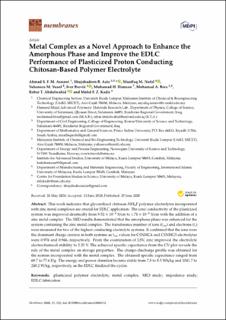| dc.contributor.author | Asnawi, A. S. F. M. | |
| dc.contributor.author | Aziz, S. B. | |
| dc.contributor.author | Nofal, M. M. | |
| dc.contributor.author | Yusof, Y. M. | |
| dc.contributor.author | Brevik, Iver Håkon | |
| dc.contributor.author | Hamsan, M. H. | |
| dc.contributor.author | Brza, M. A. | |
| dc.contributor.author | Abdulwahid, R. T. | |
| dc.contributor.author | Kadir, M. F. Z. | |
| dc.date.accessioned | 2021-02-26T07:00:41Z | |
| dc.date.available | 2021-02-26T07:00:41Z | |
| dc.date.created | 2020-06-29T11:19:06Z | |
| dc.date.issued | 2020 | |
| dc.identifier.citation | Membranes. 2020, 10 . | en_US |
| dc.identifier.issn | 2077-0375 | |
| dc.identifier.uri | https://hdl.handle.net/11250/2730520 | |
| dc.description.abstract | Abstract This work indicates that glycerolized chitosan-NH4F polymer electrolytes incorporated with zinc metal complexes are crucial for EDLC application. The ionic conductivity of the plasticized system was improved drastically from 9.52 × 10−4 S/cm to 1.71 × 10−3 S/cm with the addition of a zinc metal complex. The XRD results demonstrated that the amorphous phase was enhanced for the system containing the zinc metal complex. The transference number of ions (tion) and electrons (te) were measured for two of the highest conducting electrolyte systems. It confirmed that the ions were the dominant charge carriers in both systems as tion values for CSNHG4 and CSNHG5 electrolytes were 0.976 and 0.966, respectively. From the examination of LSV, zinc improved the electrolyte electrochemical stability to 2.25 V. The achieved specific capacitance from the CV plot reveals the role of the metal complex on storage properties. The charge–discharge profile was obtained for the system incorporated with the metal complex. The obtained specific capacitance ranged from 69.7 to 77.6 F/g. The energy and power densities became stable from 7.8 to 8.5 Wh/kg and 1041.7 to 248.2 W/kg, respectively, as the EDLC finalized the cycles. | |
| dc.language.iso | eng | en_US |
| dc.publisher | MDPI | en_US |
| dc.rights | Navngivelse 4.0 Internasjonal | * |
| dc.rights.uri | http://creativecommons.org/licenses/by/4.0/deed.no | * |
| dc.title | Metal complex as a novel approach to enhance the amorphous phase and improve the EDLC performance of plasticized proton conducting chitosan-based polymer electrolyte | en_US |
| dc.type | Peer reviewed | en_US |
| dc.type | Journal article | en_US |
| dc.description.version | publishedVersion | |
| dc.source.pagenumber | 21 | en_US |
| dc.source.volume | 10 | en_US |
| dc.source.journal | Membranes | en_US |
| dc.identifier.doi | 10.3390/membranes10060132 | |
| dc.identifier.cristin | 1817516 | |
| cristin.ispublished | true | |
| cristin.fulltext | original | |
| cristin.qualitycode | 1 | |

